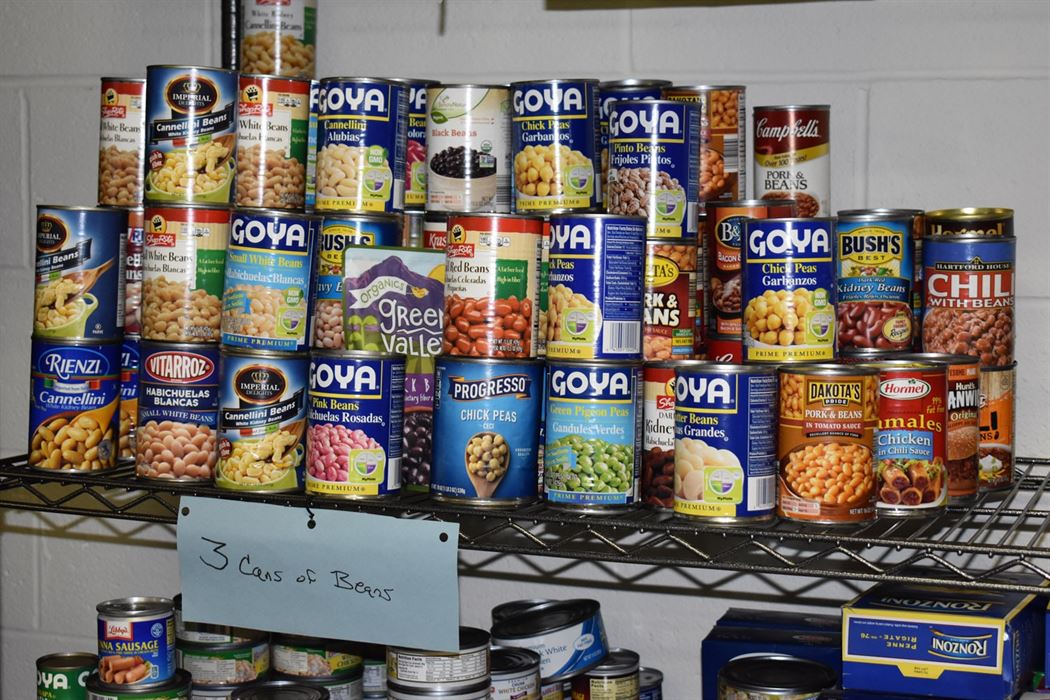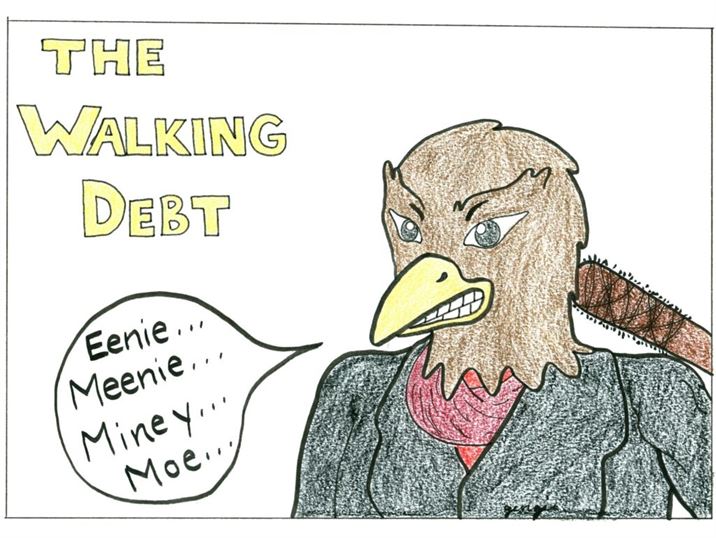SPECIAL REPORT: Students Struggle Financially to Attend Montclair State University
In the depths of the Student Center beyond the ID card office, there is a sign featuring Montclair State University’s mascot, Rocky the Red Hawk, pointing to one of the university’s newest services for its students: a food pantry.
At the pantry, students can swipe their ID cards and receive a red tote bag to fill with items from the pantry. Each student is allowed to select one household or personal hygiene item, along with three cans of food.
On the left is a table full of used coats and black lockers with additional non-perishable food. On the right, a refrigerator is filled with dairy products and meats.
The Red Hawk Pantry assists between 20 and 60 students each week who suffer from food and financial deficits. It is sustained by contributions from Montclair State alumni, parents, employees and other students.
The pantry’s most popular items are feminine hygiene products, laundry detergent and produce, according to Sonja Tillman, the coordinator of the Red Hawk Pantry. Other items in high demand are granola bars, cereal and canned foods like chicken, meat, fish and beans.
“It is truly heartbreaking to know that students have to worry about where their next meal is coming from,” said Associate Director of the Office of Alumni Relations, Stacy Albanese, who helps run the pantry.
The opening of the pantry in April 2016 was to address the troubling reality that some students at Montclair State are stressed by the uncertainty of where they will get their next meal. A university survey of 192 of its own students uncovered more than a third in need of food on a regular basis as well as 10 percent of students who see it as an unrelenting daily struggle.
Montclair State administrators asked 192 students in 2016: Do you find yourself in need of food and other basic necessities and cannot obtain them?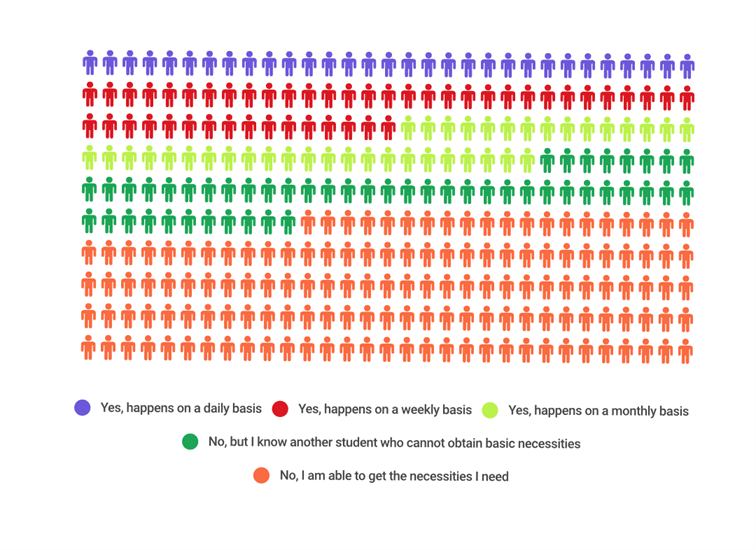
In the shadows of these hardships, administrators say they hear tales of homeless students sleeping in the library and various lounges scattered throughout the campus.
On top of the compounding stress of having to provide themselves food and shelter, students are tasked with navigating the dreaded Financial Aid Office with its long lines, deregulation and, students say, the indifference of its staff.
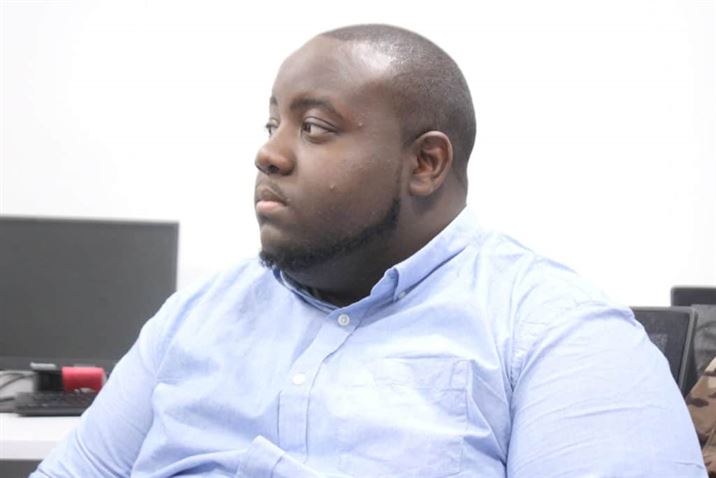
Shanard Seabrooks has achieved balance in his life under intense pressure.
Georgia I. Salvaryn | The Montclarion
Food is just one of the many things concerning Shanard Seabrooks, a junior international business major. He is the oldest child of four and assists his single mother financially. His family has no home, so Seabrooks has resorted to bunking with his godparents.
Though he would like to take advantage of the pantry for microwavable items and cereal, Seabrooks is unable to because his $400 meal plan does not allow him entry.
Entering his sophomore year, Seabrooks’ low grades resulted in decreased financial aid. He was eventually placed on academic probation. He has had to learn to achieve a balance in his life under intense pressure.
“I have sacrificed sleep, extracurricular activities and spending time with friends,” Seabrooks said. He has since pulled his grades up to Bs and Cs and is on track to graduate in 2019. “This is all part of adulthood.”
Necessity: The Mother of Invention
Because of their hardships, students have discovered creative ways to make ends meet.
Daniel Diner, a junior exercise science major, avoids brand-name items at the grocery store for more generic labels. He also uses half milk and half water in his protein shakes so milk lasts longer.
A do-it-yourself approach has been embraced by Christian Paniccioli, a junior nutrition and food science major. He built his own desk, a tower for his cat, Killua, and even cobbled together a computer from used parts. Paniccioli figures that building his own computer saved him about $700.
Nick Novakowski, a junior history major, is a true penny pincher, picking up loose change from the ground and checking the prices at vending machines on campus. He is quick to point out that not all charge the same prices for the same items.
The High Cost of Higher Education
“Pricing can be very expensive, especially if you want something small,” said Jada Fordyce, a junior fashion studies major. “A bag of peanuts is three something for no reason when you can go to CVS and get the same snack for $1.99.”
Fernanda Cavallo, a freshman childhood education major, agreed.
“I find the Student [Center] Cafe to be expensive,” Cavallo said. “The Dunkin’ Donuts is a lot more expensive than the one at my house. It’s an extra dollar and some cents more.”
Manager of Dining Services, Student Development and Campus Life James Robinson offered an explanation without a solution.
“When we discuss the pricing of retail items such as Odwalla Juice to the same juice offered by large retailers like Walmart, Target and ShopRite, we fully recognize that our pricing is higher,” said Robinson, who blamed the university’s comparatively lower volume for the disparity.
Still, he felt that a Constant Pass with 250 Flex Dollars is an example of a good value offered by Montclair State. It is priced at $2,225 per semester, which means it costs students $1,975 excluding the 250 Flex Dollars. Over the course of 107 days, it equates to an unlimited amount of food for $18.46 per day.
“It would be very difficult to find local restaurants where a student can eat unlimited amounts of quality, appetizing food at that price,” Robinson said.
Financial Hardship Hits Hard
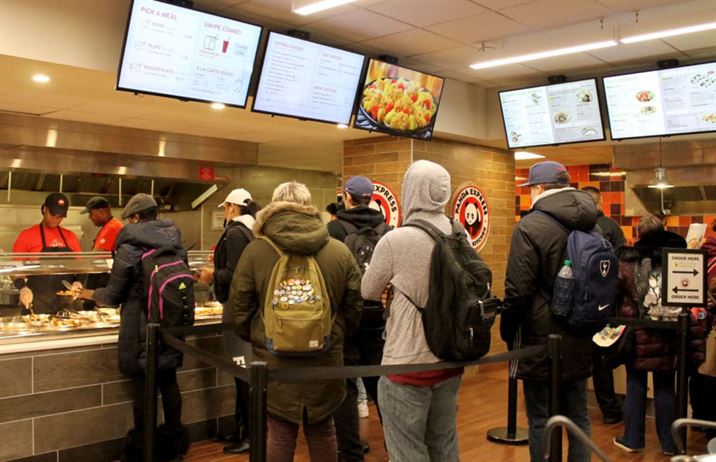
Students say part of the struggle is the higher cost of food on campus.
Georgia I. Salvaryn | The Montclarion
Even with financial aid in place and outside-the-box thinking for saving money, some students continue to be stressed by other experiences such as registration and dealing with the financial aid office.
Frequent complaints include an inability to reach staff that can help with problems, including the removal of holds placed on accounts and the need to acquire special permits. These types of issues prevent students from registering for classes.
“I had to get a permit to register for a certain course and by the time I received the approval, the class was closed,” said junior journalism major Tiffany Baskerville. “I sent emails and left messages that were not answered.”
The financial aid office was unavailable for comment but previously said that the office is pushing for better communication to reach students and alleviate their stress.
Students are not the only ones affected by the high cost of higher education. The expense is something shared by the parents of students attending universities such as Montclair State.
Maddy Patterson and her husband made good on their commitment to send all four of their children to undergraduate school. Because of that, one of the rooms in their five-bedroom house in Cranbury, New Jersey is rented out for additional income.
The Pattersons, whose youngest daughter is an English major at Montclair State, have no equity in their suburban home and do not have enough time to recoup what they have spent on college tuition for their children before retirement.
“People our age go on cruises,” Maddy Patterson said. “We’re not in terrible shape, but it’s tough.”
One Hand Washing the Other
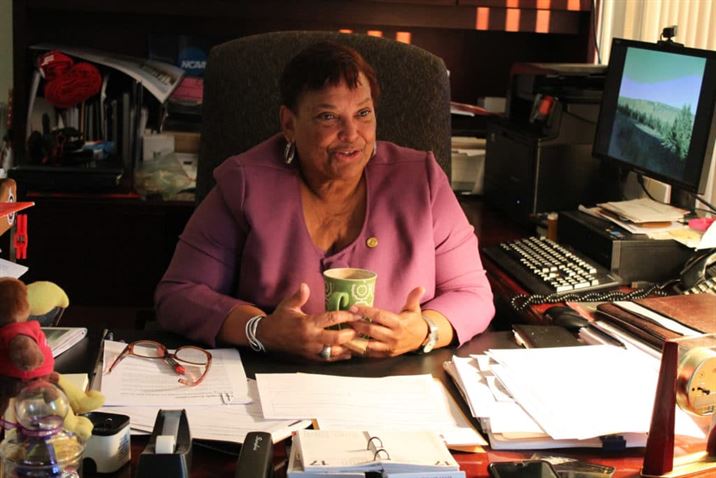
Dr. Karen Pennington, vice president for Student Development and Campus Life, brought the pantry to campus. Georgia I. Salvaryn | The Montclarion
Vice President for Student Development and Campus Life Dr. Karen Pennington understood how these hardships affect students. She is responsible for making sure the staff is devoted to student growth and development.
“The university is giving more and more money each year for students to get an education,” Pennington said. “We hold presentations about financial security, and we also try to hire as many students as we can on campus.”
Pennington emphasized the difficulties of a university receiving the funds necessary to operate. She cited students avoiding paying tuition is a way Montclair State loses millions of dollars each year.
“We’ve tried a number of things to make students pay their bills on time, but we’ve found if you threaten to take students’ Canvas away, they start to take action,” Pennington said.
Still, Pennington is not callous to the stress of students. The Red Hawk Pantry was her idea.
An incident at school when Pennington was a resident assistant director in the 1970s led to her investigating student complaints about a roommate who smelled. She found that determination to get into college left the student with no soap, deodorant or laundry detergent to wash clothes.
She brought that experience to Montclair State and used it as the catalyst for her mission to assist students with hardships.
“Put your pride aside and realize [that] everyone needs help once in a while,” Pennington said. “We need others to turn to.”

